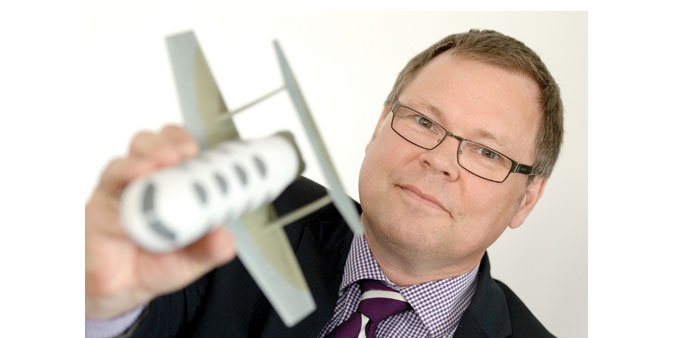By Amadeus Ulrich
After a piggy-back lift into the skies atop an airplane, the space plane suddenly breaks away and its hydrogen-powered rockets send it hurtling up towards the heavens.
Higher and higher the space vehicle goes, more than 100 kilometres up. A soothing woman’s voice talks to passengers over the intercom and now, the stars are visible as the glider with its panorama windows flies in a parabolic trajectory.
Some time later, it lands back on earth. Such is the vision.
As projected by V-Plane, a Hamburg company that designs small aircraft, the space ride would cost 150,000 euros (185,000 dollars) per person.
The idea has been partially developed, but so far, it’s only virtually available, as a video film, because the project isn’t making much headway.
“It’s simple in principle,” says Joachim Lau, chief executive of V-Plane as he sits in his office. Next to him is a model of the so-called suborbital aircraft, which would carry eight passengers.
Its initial ascent, on a regular plane, would take it to an altitude of 12 kilometres, before the rockets fire.
For five minutes at the top of the trajectory, the passengers would experience weightlessness.
Booster, an international consortium based in Belgium, commissioned the Hamburg company six years ago to help it conceive the project.
Altogether, more than 30 companies have taken part, but so far, nothing has been built.
“We have flown a simulated mission,” Lau said. “Now the market for it has to open up.”
This is where the problem lies. Two years ago, Booster founder James Murray predicted that the first tourist space flights would be possible in 2016. But this target proved too ambitious. Now the forecast is for the end of the decade, at the earliest.
Why the delay? People quickly point to the US company Virgin Galactic, owned by multi-billionaire Richard Branson, who likewise wants to provide suborbital flights for paying customers.
His first mission was supposed to take place in 2009, but has faced repeated postponements. Investors are holding back until they can see a successful flight demonstrated, Murray says. The project would “pave the way” for commercial space travel.
So far, 600 people have booked tickets at 250,000 dollars each.
Ulrich Walter, a former astronaut and now professor of space technology at the Technical University of Munich, says that the propulsion system is the chief problem.
Virgin Galactic is now under enormous pressure. Next year, at the earliest, a flight is possible.
In Europe, meanwhile, the money for space travel is lacking. In addition there are legal as well as insurance issues, Walter notes.
The former astronaut does not believe that a broader market will be created if Virgin Galactic succeeds in carrying out the first mission. If that happens, “they will clean up the market quick as a
flash.”
It is also questionable whether the European Aviation Safety Agency (EASA) will permit the Booster project.
“We can’t promise anything,” says Jean-Brunno Marciacq, the man in charge at EASA of drafting the regulations for this type of air travel. A licence from the agency is absolutely essential, he notes.
“Then they (the developers) would win over the confidence of investors and potential passengers.”
He said EASA would be open to working out possible compromises.
Europe needs a security concept for this new type of aircraft, Marciacq adds, something similar to the US Federal Aviation Administration’s Licensing System that was set up in 2004.
“To develop this in Europe is more complicated and can take longer, because both the European Commission and European Parliament must approve,” he said.
In contrast to today’s conventional passenger air travel, passengers aboard suborbital flights must first undergo training and obtain a clean bill of health. But Marciacq says that space tourism would be
merely the “tip of the iceberg” in that there is also interest on the part of the scientific community in such flights.
They would create more and cheaper opportunities for carrying out experiments in a state of weightlessness.
“Molecules and crystals form [in space] better than on earth. New medicines and metals could be manufactured in this way.”
In the distant future it would even perhaps be possible to fly from, say, Hamburg to New York in one and a half hours with suborbital spacecraft, Murray says.
“This would come at the end of the chain of development.”
Five companies around the world are now tinkering with comparable projects. The question remains: who will launch the first actual mission. — DPA



